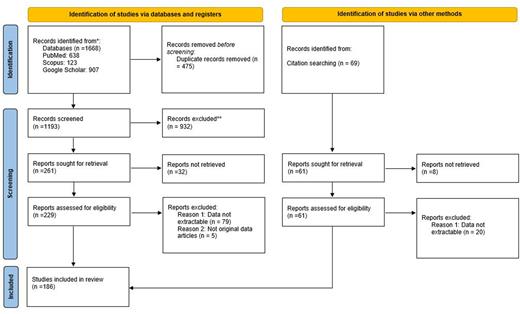Abstract
Introduction
Sickle Cell Disease (SCD), one of the common hemoglobinopathies, has a progressively increasing prevalence. Different genotypes of variants of SCD result in a spectrum of clinical manifestations. With SCD being a genetic disease, it is influenced by ethnicity and regional differences in its clinical course. There are recent advances in the management of SCD with newer therapies being introduced to the Western population. However, many of these treatments are yet to be used in the Arabic SCD population. It is important to understand the genetic variations of SCD regionally to anticipate the effectiveness of these newer modalities. This systematic review's main objective is to pool the available data on the genetic composition of SCD in the Arabic population.
Methods
We searched English language articles from PubMed, Scopus, and Google Scholar that reported genotypes of patients with SCD in countries of the Arab world. Demographics, prevalence, genotypes, clinical characteristics, management, and outcomes of patients were extracted and analyzed in the form of a systematic review. Descriptive and summary statistics were used to present the data and the mean (with standard deviation) and mode (with interquartile range) were reported as appropriate.
Results
Data for 44259 patients was extracted from 186 studies (case reports, case series, retrospective, and prospective observational studies). Male (49%) and female (51%) patients were equally reported wherever gender was available (N=13105). Most cases were reported from Saudi Arabia (>50%), and Bahrain (27.24%). The percentage of included cases was lower than 5% in Jordan, Egypt, Kuwait, and Tunisia, and less than 2% in the remaining Arab countries. Various SCD genotypes were reported in a total of 14482 patients, including Hb SS (76%) Hb Sβ0 (9.7%), and Hb Sβ+ (7.1%), while the rest of the genotypes, including HbSC, HbSD, HbSE, HbSO Arab, Hb S/α-Thal, Hb Sβ0 + α-Thal, and HBS Oman were individually reported in <4% of the cases. Major SCD complications in the Arab population included pain crises (48.25%) followed by neurological complications (33.46%), hepatobiliary complications (25.53%), musculoskeletal complications (24.73%), and hemolytic anemia (23.57%). The treatments reported for SCD included hydroxyurea (20%), blood transfusion (14.32%), and Deferasirox (3.03%). We did not find the use of stem cell transplantation or newer treatments such as L-Glutamine, Voxelotor, Crizanlizumab, or gene therapy reported in any of the studies included in our review.
Conclusion
SCD is a common hemoglobinopathy in the Arab population. Data with regards to its genotypic makeup in the region is scattered and is different from the other parts of the world. Many of the approved treatment modalities are yet to be reported in this patient population. This review highlights the genetic makeup of SCD in the Arab countries and common phenotypic manifestations. This data will help the direction of further research on SCD in this region, especially with respect to the upcoming era of genetic therapy.
Disclosures
No relevant conflicts of interest to declare.
Author notes
Asterisk with author names denotes non-ASH members.


This feature is available to Subscribers Only
Sign In or Create an Account Close Modal